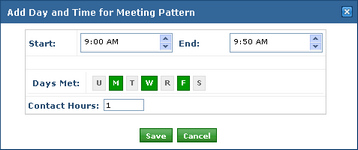Meeting Patterns |

|

|

|

|
A meeting pattern is a specific combination of meeting times and days that may be assigned to an academic course section offering. A meeting pattern record includes the time/day combination, contact hours, term types and campus/meeting type combinations for which the pattern is valid, and whether or not the pattern is a "standard" for any of the campus/meeting type associations. Additionally, usage statistics are provided per term type and campus/meeting type association. Meeting pattern information maintained in Astra Schedule may be used to help enforce the adherence to "standard" patterns when editing sections and to provide insight into pattern usage at your institution.
If academic section data is being imported from a student information system, distinct meeting pattern records will be automatically captured and added to the Astra Schedule database as they are imported. However, meeting patterns may be manually added and edited directly in Astra Schedule as well. In either case, the categorization of "standard" patterns must be configured manually.
To find the list of meeting patterns in the Astra Schedule system, click the Meeting Patterns option on the Academics tab.

A list page is displayed with all meeting pattern records either captured by a section import process or created manually. As with other list pages, the list may be filtered by using the filter options presented in the panel to the left of the list. After entering filter options, click Search to update the list results.
From the list page, click on the pattern name link you would like to view.

The meeting pattern detail form is displayed. Following are highlights of the details provided:
Display Name
The Display Name is automatically created for "recurring" meeting patterns and simply reflects the day/time combination created for the pattern. This value is not editable unless the pattern type is "continuous".
Pattern Type
There are two Pattern Types possible - "recurring" or "continuous". Recurring patterns repeat the day/time combination during a date range and are most commonly used by traditional 2 and 4 year institutions. Continuous patterns do not repeat, but instead meet continuously until the contact hours are met. Continuous patterns are most commonly used by for-profit, government, and training institutions.
Is Active
The Is Active flag determines whether or not the pattern is available for processes within Astra Schedule, including pattern assignment at the section level.
Is Exam
The Is Exam flag designates a meeting pattern as an exam meeting pattern. Only exam meeting patterns may be used when creating times for exam section meetings.
Total Contact Hours
The Total Contact Hours is a roll-up value representing the total of the contact hours from the individual meeting pattern times.
Meeting Pattern Times
The Meeting Pattern Times section of the form includes the individual meeting instances that make up the pattern.
![]() NOTE: Meeting Pattern Times cannot be edited if the meeting pattern is associated with a course section offering.
NOTE: Meeting Pattern Times cannot be edited if the meeting pattern is associated with a course section offering.
Term Types
The Term Types section of the form displays valid term types for the pattern, including usage statistics per term type.
Campus/Meeting Types
The Campus/Meeting Types section of the form displays the valid campus/meeting type combinations for the pattern, including usage statistics per combination. Each campus/meeting type combination may be flagged as "standard".
Meeting Pattern records are typically created automatically by the system during section record imports. However, patterns may be created manually as well. To add a meeting pattern to the list, perform the following:
1.Click the Meeting Patterns option from the Academics tab.

2.Click the New button.
3.Select "Recurring" or "Continuous". ("Recurring" is the typical pattern type for institutions with semester course offerings)
4.If the meeting pattern is to be used for exam meetings, place a check in the box next to "Is Exam".
5.Click the Add button in the Meeting Pattern Times section of the form.
6.In the Day and Time window, enter the start and end time, days, and contact hours for the meeting pattern being created.

7.Notice that the meeting pattern instances are generated from the pattern information entered. The time and contact hour values are applied to each day instance created

8.Repeat the process as needed, and/or edit and delete the instances until the pattern is represented correctly.
![]() NOTE: Meeting Pattern Times cannot be edited if the meeting pattern is associated with a course section offering.
NOTE: Meeting Pattern Times cannot be edited if the meeting pattern is associated with a course section offering.
9.Click the Add button in the Term Types section of the form.
10.Select a term type for which the meeting pattern is valid and click Save. The term type is added to the pattern. This may be repeated for all valid term types.

11.Click the Add button in the Campus/Meeting Types section of the form.
12.Select a campus and meeting type combination for which the meeting pattern is valid. Optionally, place a check in the box labeled "Is Standard" to specify that the pattern is a standard meeting pattern for the campus/meeting type combination specified. Click Save to add the combination to the pattern. Repeat as needed.

13.Click Save on the meeting pattern form to save the pattern information and return to the meeting pattern list page.
Page url: ?academics_meetingpatterns.htm